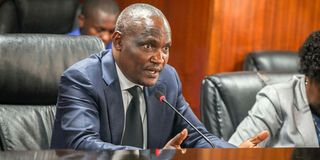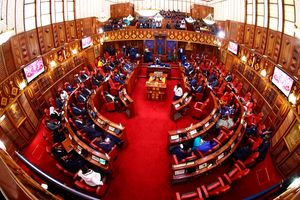
Cabinet Secretary for National Treasury and Economic Planning John Mbadi before the National Assembly Public Debt and Privatisation Committee at Continental House Nairobi on November 28, 2024.
Questions are being raised over who will finance the extra Sh41 billion contained in the budget deficit that National Treasury Cabinet Secretary John Mbadi read to Kenyans last week in the National Assembly.
The Budget and Appropriations Committee (BAC) in its report on the Sh4.2 trillion estimates for the 2025/26 financial as adopted by the House, approved the budget deficit of Sh876.1 billion.
However, in his speech to the House on June 12, 2025, on the budget highlights and revenue raising measures for the country in the next financial year, CS Mbadi put the budget deficit at Sh923.2 billion, which is more than what the MPs approved by Sh41 billion.
The adjustments were informed by increases to various votes by the MPs during the House’s Committee of Supply where Sh21.8 billion was additionally allocated to the State Department for Roads, Sh5.2 billion to parliament, Sh2 billion to the Ministry of Defense and Sh12 billion in cumulative increases across other votes.
This comes as Alego Usonga MP Samuel Atandi, the BAC chairperson, said that the budget deficit figure remains as approved by the House.
“Definitely as the budget making body, the figure as approved by the National Assembly carries the day,” said Mr Atandi even as he noted the revenue projection differences between what the House adopted and what the National Treasury read to the country.
CS Mbadi had yet to respond to our questions on the same by the time of going to the press. We called and also sent a short message to his known number.
Unexplained budget deficit emerges
The deficit is though expected to increase beyond the Sh923.5 billion considering that the mediation process on the Division of Revenue Bill (DoRB) 2025 that divides funds equitably between the national and the county government, has not been concluded.
“The final deficit will be known once the DoRB has been passed. It may increase beyond what we already know putting the country on the line of increased taxation or borrowing,” an MP who requested anonymity said.
DoRB, as passed by the National Assembly, had allocated county governments Sh405 billion for the 2025/26 fiscal year.
However, the Senate, on considering it, revised the figure upwards to Sh465 billion forcing the Bill to go to the mediation process.
On Wednesday, the Mediation Committee on the Bill had settled for Sh415 billion as the amount to be sent to counties equitably pending adoption of its report by the two Houses.
While the National Assembly was able to rationalise the estimates so as to raise Sh5 billion for the DoRB as the Senate remained firm, the additional Sh5 billion that has since seen the mediation committee reach consensus is outside the budget framework as approved by the National Assembly.
A history of moving targets
This means that it will raise the fiscal deficit beyond what CS Mbadi read on the floor of the House.
In the last decade, Kenya’s budget deficit has been a moving target fashioned by the many supplementary budgets that the National Assembly approves, meaning that the country’s actual budget deficit figure will only be told at the close of the financial year on June 30th every year.
This even as BAC underscored the need for fiscal discipline in maintaining the projected deficit throughout the financial year rather than reviewing it during the many supplementary estimates.
Based on the outlined policy measures and structural reforms, total revenue collection, including Appropriation-in-Aid for the 2025/26 financial year budget, the National Treasury projects to collect Sh3.32 trillion to finance the budget.
The Finance and National Planning Committee of the National Assembly in its report on the consideration of the Finance Bill 2025, projects it to raise Sh24 billion in additional revenue generation, contributing to Sh3.32 trillion as outlined by the National Treasury.
The projections by the National Treasury, which is equivalent to 17.2 percent of the GDP, includes ordinary revenue projection of Sh2.8 trillion, about 14.3 percent of GDP and Appropriation-in-Aid (AiA) projection of Sh567 billion with grants projected at Sh46.9 billion.
Although CS Mbadi, an accountant, was not available to comment on the variances, Kitui Central MP Dr Makali Mulu, an economist, warned the National Treasury against pushing the burden of the extra budget deficit onto Kenyans.
“What CS Mbadi read to the House in terms of budget deficit and what this House approved in its consideration of the budget estimates are two different figures,” said Dr Mulu.
The Kitui Central MP continued; “we must be told where the difference of the Sh47 billion in the budget deficit will come from.”
“I hope it will not be coming from additional taxation,” warned Dr Mulu.
According to Mr Mbadi, the projected budget deficit of Sh923.2 billion including grants is equivalent to 4.8 percent of GDP down from the estimated Sh997.5 billion or 5.7 percent of the GDP in the current financial year.
The Treasury CS noted that the fiscal deficit for the 2025/26 budget will be financed by net external borrowing of Sh287.7 billion and net domestic borrowing of Sh635.5 billion.
The fiscal deficit projected by BAC, is a “modest improvement” from the Sh887.2 billion in revised estimates for the 2024/25 financial year and a slight increase compared to the Sh867.7 billion that was presented in the 2025 Budget Policy Statement (BPS).
The deficit, according to BAC, will be plugged through borrowing of Sh284.2 billion from the external market and Sh591.9 billion from the domestic market with the committee warning against reliance on internal borrowing.
“Despite the declining interest rates on government securities locally due to the easing monetary policy stance, continued reliance on domestic borrowing may either crowd out credit to the private sector or result in high borrowing costs for the private sector,” the BAC report reads.
Increased sllocations to State Agencies
Conversely, the targeted commercial financing will be subject to global market dynamics, which may necessitate changes in the borrowing strategy.
At the same time, a number of government entities have received more allocations.
Other than State House’s Sh2.8 billion, the other State agencies that have been granted additional allocation by the National Treasury include State Department for Social Protection and Senior Citizen Affairs Sh12.5 billion that has had Sh6.9 billion withdrawn on May 15, 2025.
There is also Sh11.7 billion for the State Department for roads, Sh6.5 billion for the State Department for Transport, Sh5 billion for the National Treasury and Sh3.5 billion for State Department for Information Communication Technology and Digital Economy.
The National Intelligence Service (NIS) has been allocated additional Sh2 billion with Sh100.6 million withdrawn on May 6, 2025, State Department for Sports Sh1.7 billion for African Nations Championship (CHAN) hosting rights.
The CHAN allocation was withdrawn on April 4, 2025 and therefore falls outside the constitutional timeline that requires the approval of the National Assembly to be sought within two months of the first withdrawal.
NIS, which is audited by the Office of the Auditor-General though the findings are highly moderated, was allocated Sh9.8 billion in additional expenditures in March this year, which is on top of the Sh46.4 billion that was appropriated by MPs in June 2024.
This means that by the time this financial year closes on June 30, 2025, NIS’ cumulative budget will be Sh58.2 billion inclusive of the extra Sh2 billion being sought for approval.
While seeking the additional allocation to State House in March this year, the National Treasury, without elaborating further, said; “the increase is on account of enhancement of operation and maintenance.”






